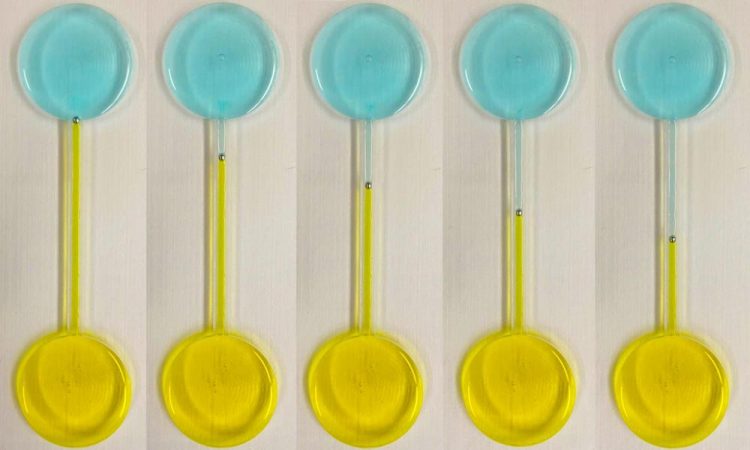Towards the T-1000: Liquid metals propel future electronics

Continuous motion of a self-propelling liquid metal droplet under a pH gradient, shown at different time intervals. The droplet is placed in a fluidic channel, midway between two reservoirs filled with different electrolytes of acidic and basic nature. Credit: RMIT University
Science fiction is inching closer to reality with the development of revolutionary self-propelling liquid metals — a critical step towards future elastic electronics.
While building a shape-shifting liquid metal T-1000 Terminator may still be far on the horizon, the pioneering work by researchers at RMIT University in Melbourne, Australia, is setting the foundation for moving beyond solid state electronics towards flexible and dynamically reconfigurable soft circuit systems.
Watch the YouTube video: http://bit.
Modern electronic technologies like smart phones and computers are mainly based on circuits that use solid state components, with fixed metallic tracks and semiconducting devices.
But researchers dream of being able to create truly elastic electronic components — soft circuit systems that can act more like live cells, moving around autonomously and communicating with each other to form new circuits rather than being stuck in one configuration.
Liquid metals, in particular non-toxic alloys of gallium, have so far offered the most promising path for realising that dream.
As well as being incredibly malleable, any droplet of liquid metal contains a highly-conductive metallic core and an atomically thin semiconducting oxide skin — all the essentials needed for making electronic circuits.
To work out how to enable liquid metal to move autonomously, Professor Kourosh Kalantar-zadeh and his group from the School of Engineering at RMIT first immersed liquid metal droplets in water.
“Putting droplets in another liquid with an ionic content can be used for breaking symmetry across them and allow them to move about freely in three dimensions, but so far we have not understood the fundamentals of how liquid metal interacts with surrounding fluid,” Kalantar-zadeh said.
“We adjusted the concentrations of acid, base and salt components in the water and investigated the effect.
“Simply tweaking the water's chemistry made the liquid metal droplets move and change shape, without any need for external mechanical, electronic or optical stimulants.
“Using this discovery, we were able to create moving objects, switches and pumps that could operate autonomously – self-propelling liquid metals driven by the composition of the surrounding fluid.”
The research lays the foundation for being able to use “electronic” liquid metals to make 3D electronic displays and components on demand, and create makeshift and floating electronics.
“Eventually, using the fundamentals of this discovery, it may be possible to build a 3D liquid metal humanoid on demand – like the T-1000 Terminator but with better programming,” Kalantar-zadeh said.
The research, which has potential applications in a range of industries including smart engineering solutions and biomedicine, is published on 4 August in Nature Communications.
In the paper, first author Dr Ali Zavabeti details the precise conditions in which liquid metals can be moved or stretched, how fluid on their surfaces moves around and — as a result — how they can make different flows.
The work also explains how the electric charges that accumulate on the surface of liquid metal droplets, together with their oxide skin, can be manipulated and used.
Media Contact
All latest news from the category: Information Technology
Here you can find a summary of innovations in the fields of information and data processing and up-to-date developments on IT equipment and hardware.
This area covers topics such as IT services, IT architectures, IT management and telecommunications.
Newest articles

Properties of new materials for microchips
… can now be measured well. Reseachers of Delft University of Technology demonstrated measuring performance properties of ultrathin silicon membranes. Making ever smaller and more powerful chips requires new ultrathin…

Floating solar’s potential
… to support sustainable development by addressing climate, water, and energy goals holistically. A new study published this week in Nature Energy raises the potential for floating solar photovoltaics (FPV)…

Skyrmions move at record speeds
… a step towards the computing of the future. An international research team led by scientists from the CNRS1 has discovered that the magnetic nanobubbles2 known as skyrmions can be…





















